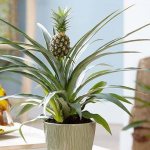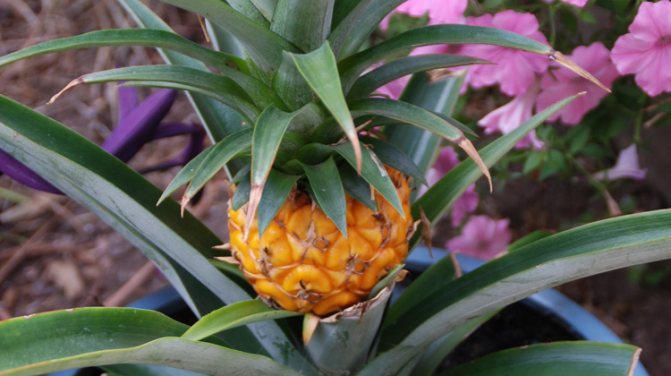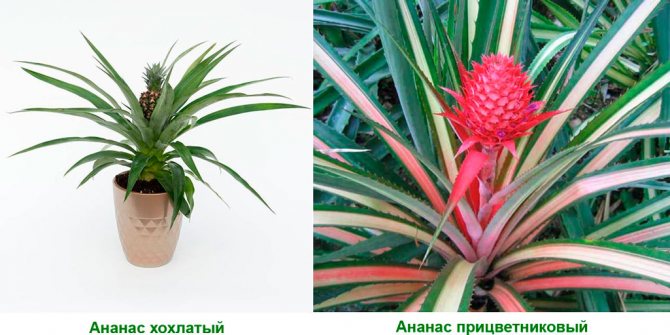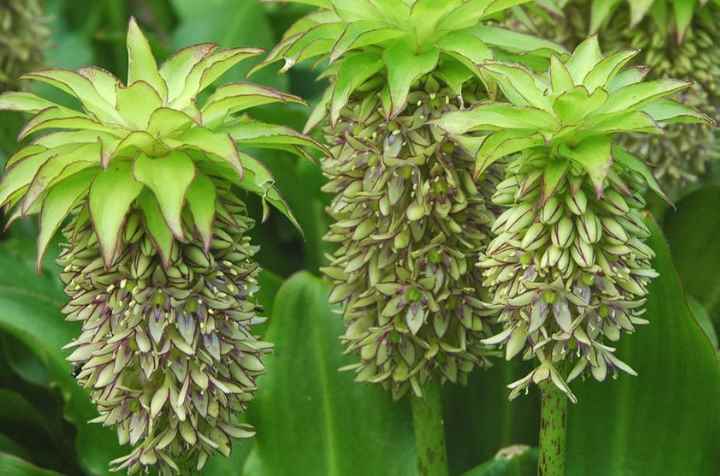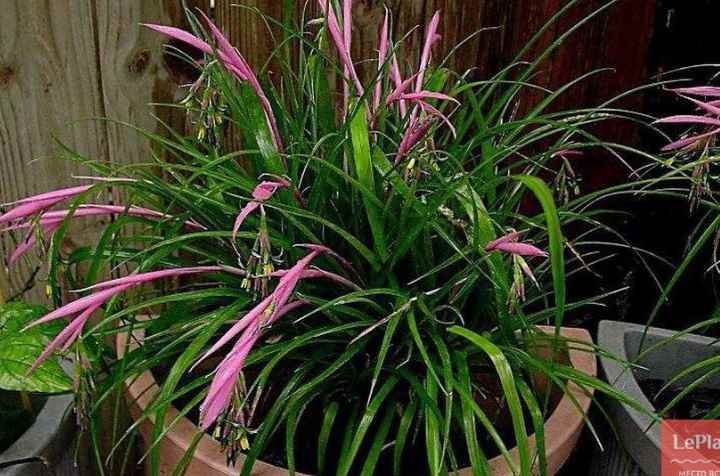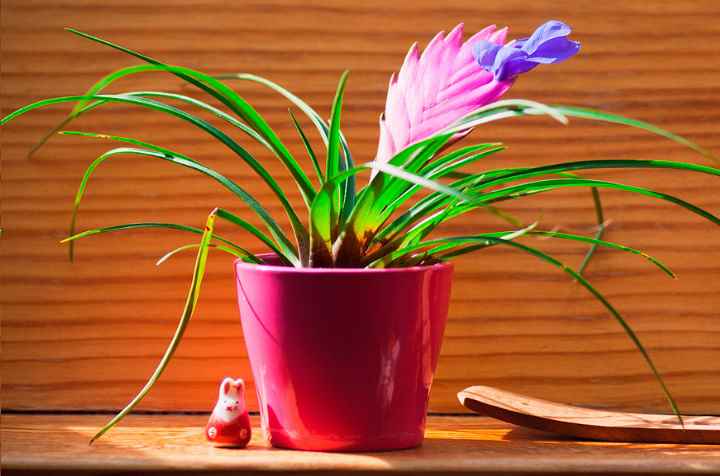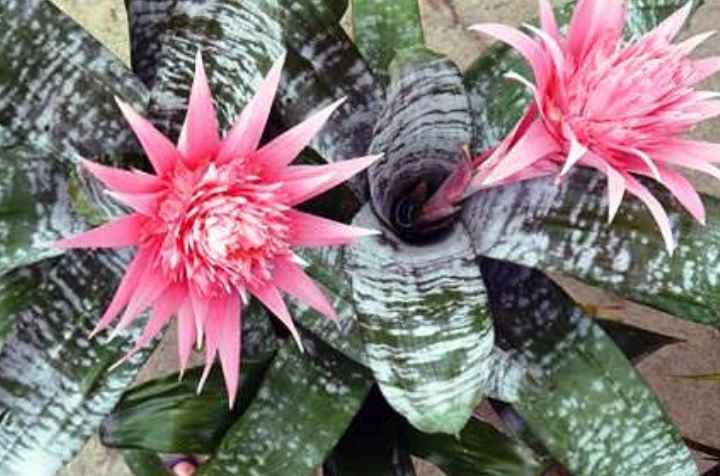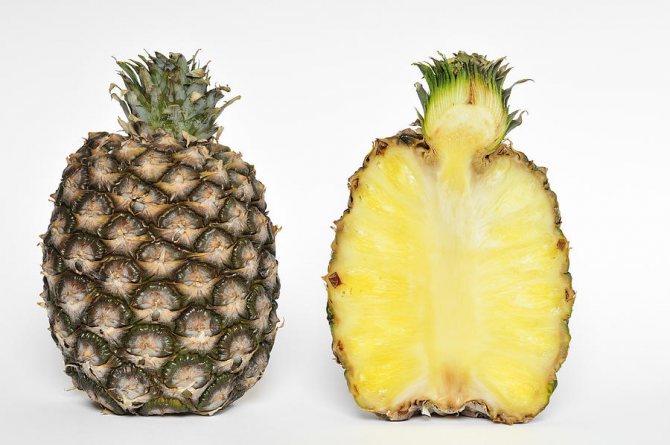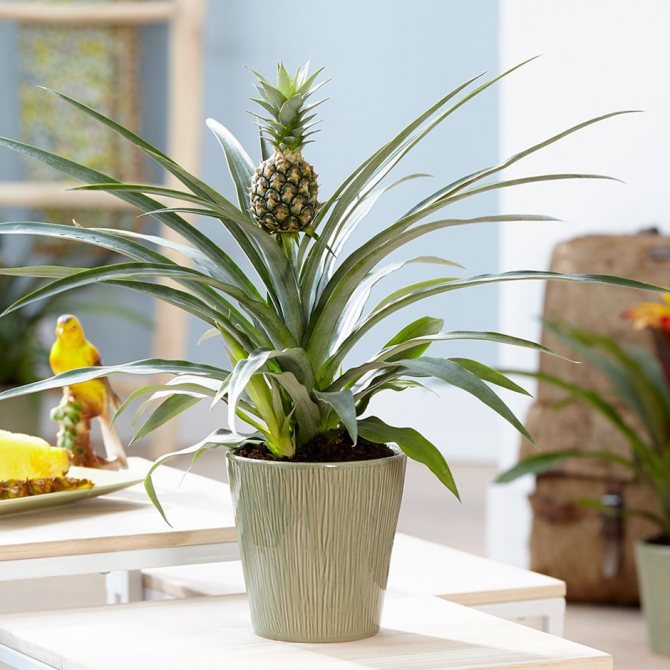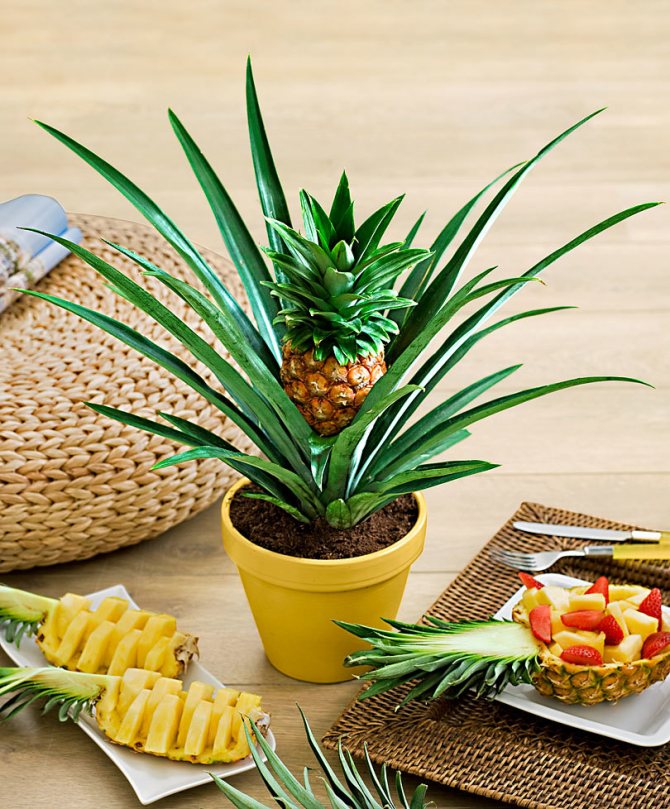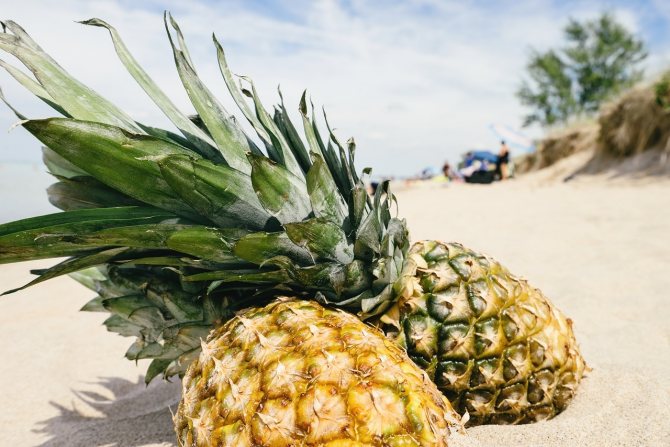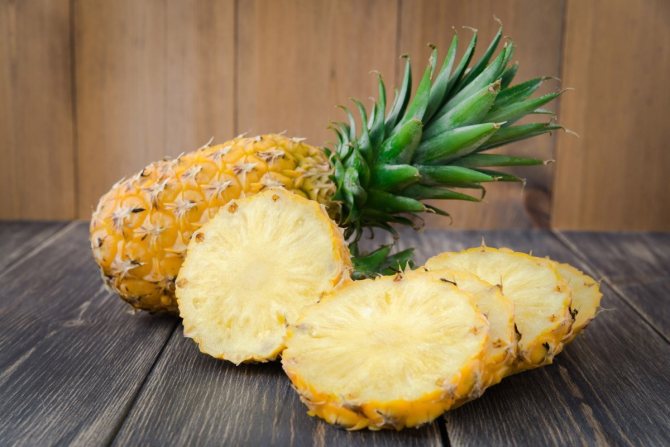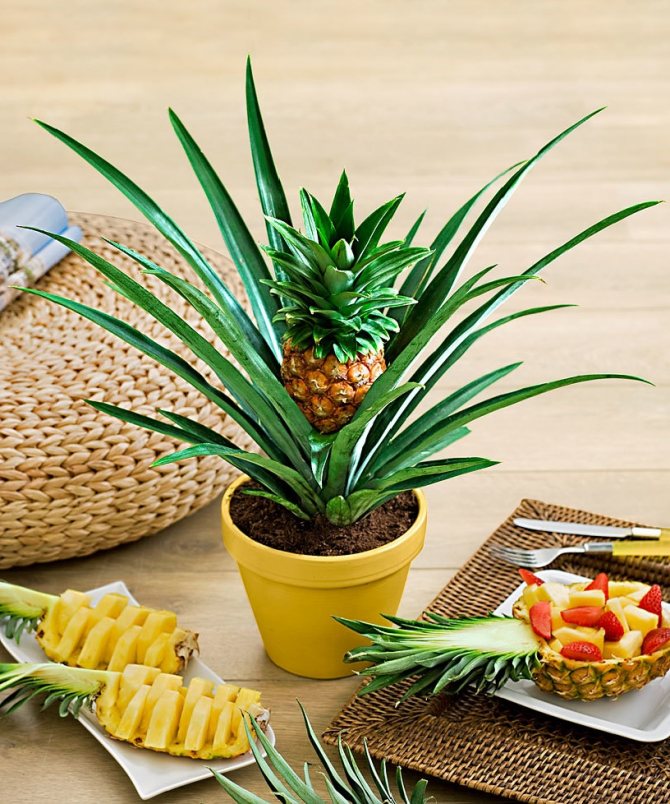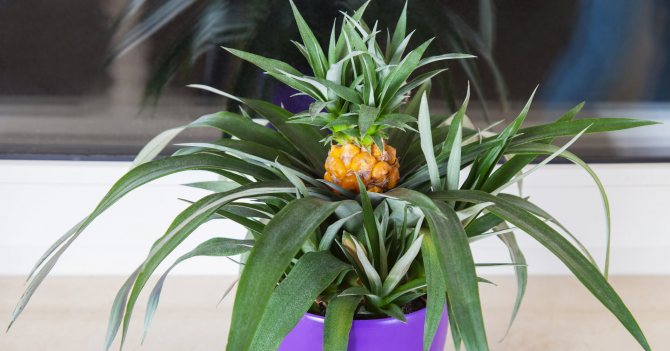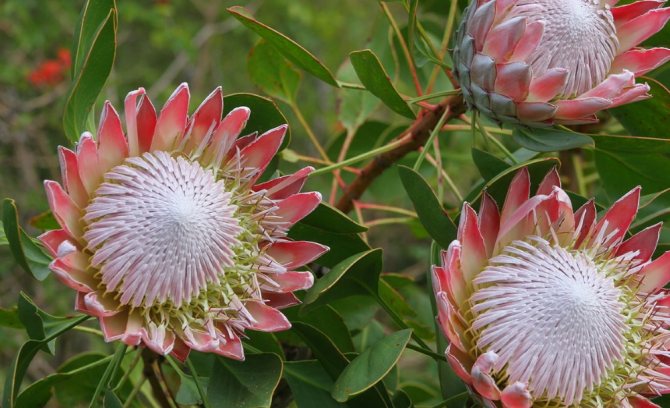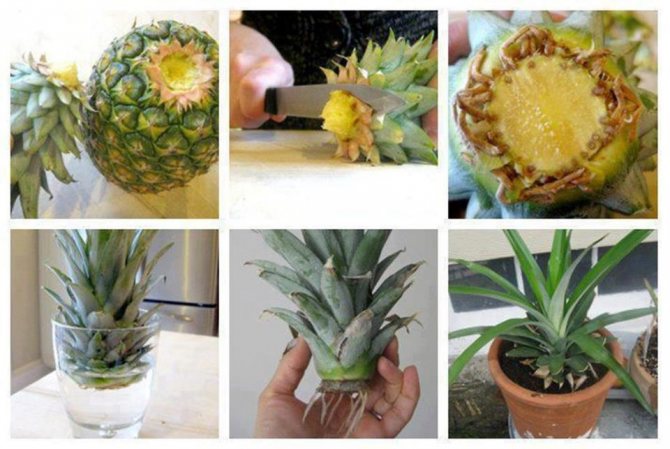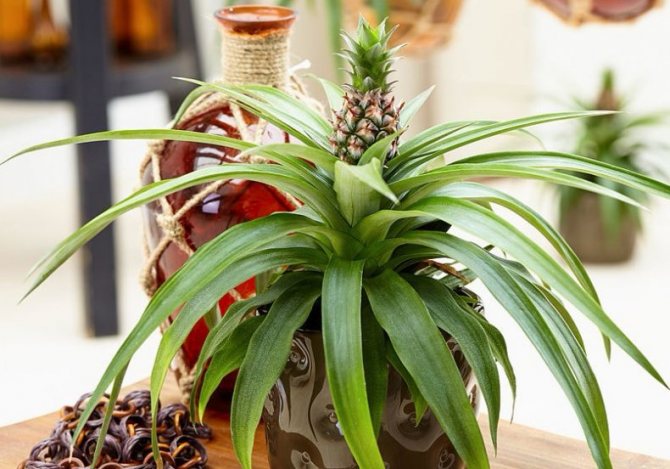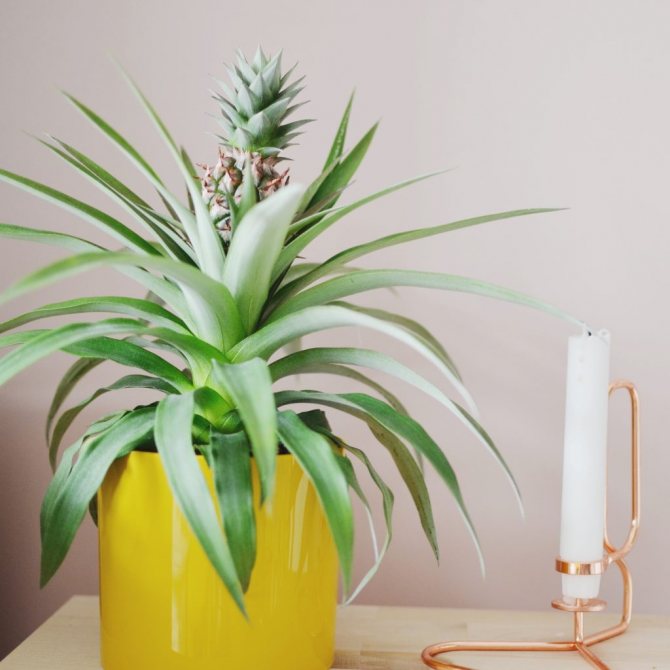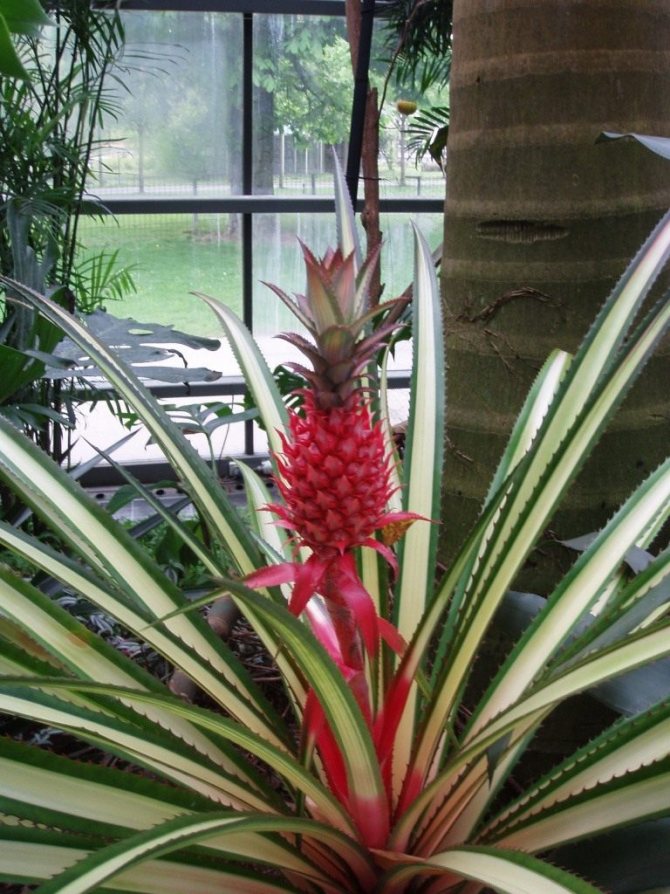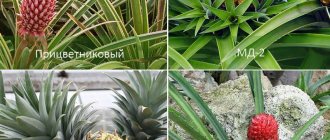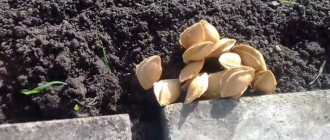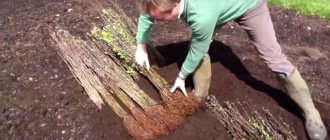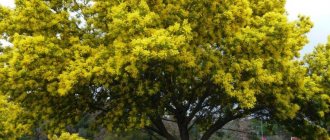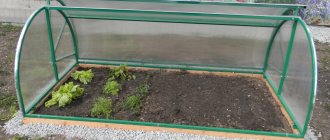Did you know that pineapple can be grown at home? This is true, but the care of such an unusual plant must be approached as responsibly as possible. This is the only way to get delicious and beautiful fruit right at home. Today you will find out all the information you need to help grow a healthy and eye-catching plant. Let's get started.
Description of the plant
Pineapple is a herbaceous plant with a stem always growing in the center. If you carefully examine it, you can see that there is an inflorescence right at the top of the stem, which later turns into an inflorescence. Separate berry parts of this fruit grow together into one pineapple.
The stem is surrounded by a rosette, which consists of leaves that are thick and fleshy. The shape of the fruit of such a plant is oval and cylindrical. It is made up of small pieces that have grown together. There is a rosette of leaves at the top of the pineapple.
The fruit itself is enclosed in a shell of scales. If the pineapple is ripe, then it can be yellow, dark green, reddish or brown. Its pulp is rich yellow.
Almost everyone has tried pineapple and knows that it tastes good and is complemented by a great aroma. If the fruit is fully ripe, then it can weigh up to five kilograms.
Description of the fruit
Tropical America gave the whole world such a wonderful fruit as pineapple. This herb belongs to the Bromeliad family. Ananas comosus is the most famous fruit crop cultivated on all known tropical plantations.
Many people think that pineapple fruits grow on palm trees, but this is a big misconception. Pineapple is a terrestrial plant that has sharp, long leaves. The length of an adult plant reaches no more than 1.5 meters and 2 meters in diameter.
The dense cover of pineapple leaves has a thick layer of epidermis. Thanks to the epidermis, during rains, the plant accumulates the moisture it needs. From the root crown (or rosette), a peduncle is formed, which has a length of up to 35-65 cm.
How to grow pineapple at home

Many exotic fruit lovers are thinking about whether it is possible to grow pineapple in a pot at home. This process is not complicated, although long. And if you have even a little experience in gardening, then this task can be easily dealt with.
In order to grow a pineapple at home, a photo of which will then decorate any album, you need to correctly perform several actions. So, initially it is worthwhile to competently approach the choice of the planting material itself. The second step is to prepare the soil and all the necessary conditions for the further maintenance of the seedling. At the third stage, the greenest pineapple top is already sprouting. Once this happens, the pineapple tuft will need to be placed in the rooting bowl. At the last stage, it will remain to carefully observe all the features of care, in particular, watering the plant.
A pineapple in a pot will grow in 2 years with proper care. In size, it will be smaller than what has grown in nature, but the taste and smell of its fruit will be simply magnificent.
Growing problems, diseases and pests
When growing an exotic fruit at home, it is important to know how the pineapple blooms and what color the leaves should be. This will help to detect the symptoms of diseases in a timely manner.Florists may face problems:
- If the plant leaves the tips of the leaves dry, the pineapple lacks moisture.
- If the watering rules are not followed, mold may form on the walls of the pot.
- The plant is actively attacked by scale insects. Symptom - small light spots appear on the leaves.
- If the pineapple is in a cold room, it will show stunted growth.
Compliance with the basic rules of planting and care will help to grow a magnificent exotic fruit on your windowsill, which in its taste will be much better than the purchased one.
Rules for choosing a plant for planting
A pineapple planted at home in a pot, a photo of which can be found in this article, requires constant care, and if it is not carried out, then the plant will not bear fruit. Particular attention should be paid to the choice of planting material.
First of all, you should carefully examine the fruit that is selected for planting. Its bright yellow-brown hue will indicate that the pineapple is ripe. If the skin on the fruit is tough, then it is not yet ripe and is not suitable for planting. If, when you press on the fruit, you can immediately feel its softness, then the plant, on the contrary, is overripe. This pineapple is also not suitable for growing.
Sometimes you can find information that the fruit will ripen easily at home if you put it in a bag with apples or hold it upside down for several days. But in reality, this is not entirely true. If you use similar methods to ripen the fruit, then its pulp will become much sweeter, as the starch gradually turns into sugars and is distributed throughout the pineapple. But at the same time, the rosette, which is necessary in order to grow a pineapple in a pot, will gradually die off.
Also, when choosing a pineapple, you should pay attention to its leaves. They should be not only green and juicy, but also intact (although the edges may still be a little dry). If the plant has gray spots, then it should not be taken for planting. After all, it is these spots that indicate that the fetus is affected by worms. But if there is a small sprout in the outlet, then, accordingly, it will be an excellent guarantee that pineapple in a pot can grow from such planting material at home. The photo below just confirms this.
When choosing a pineapple for planting, smell should be another main reference point. When buying, it is necessary to sniff at the base of the plant. A sour smell means the pineapple is overripe. And those plants that are suitable for planting should have a sweetish aroma.
To grow a pineapple in a pot, a photo of which can surprise all friends and family, you should buy it in spring or summer. To increase the chances, it is better to purchase two pineapples, but in different stores. Correctly it is worth rooting each of them to be sure that at least one will germinate.
Family Description
An exotic flower similar to pineapple leaves or flowers native to the tropics of America. The family includes several thousand plants with various characteristics. In apartment conditions, compact varieties are mainly grown, their leaves are often rosette-shaped.
Most bromeliads form a rosette from the leaves, which resembles a vase. In nature, water is collected in it, which the plant feeds on.
In the photo of plants, you can see the general characteristics of bromeliad varieties, they have tough, lily-shaped, belt-shaped leaves. They can be monochromatic or spotted and striped.
Bromeliad houseplants are considered to be flowering, but in fact this inflorescence is a bright color, but their flowers are small and ugly.
Interesting! Some varieties of bromeliads during flowering can change the color of the leaves in the funnel, so the plant looks like one large flower.
In their natural environment, the flowering of bromeliads coincides with our winter, during the dormant period of most plants. The duration of flowering is several months at the end of which the plant dies off, and children form on the side. Young rosettes grow for 3 years, after which they bloom and also leave successors. The development of side outlets is a method of propagating plants at home.
Despite the fact that the roots of tropical plants are poorly developed, the leaf rosette is able to fully nourish the plant, due to the presence of cells and scales on its surface.
Interesting! Due to the ability of the rosette to retain moisture and nourish the plant, the presence of foliar fertilizers is important for bromeliads. In summer and spring, it is necessary to spray with a solution of a low concentration of the mineral complex, twice a month.
Planting a pineapple top
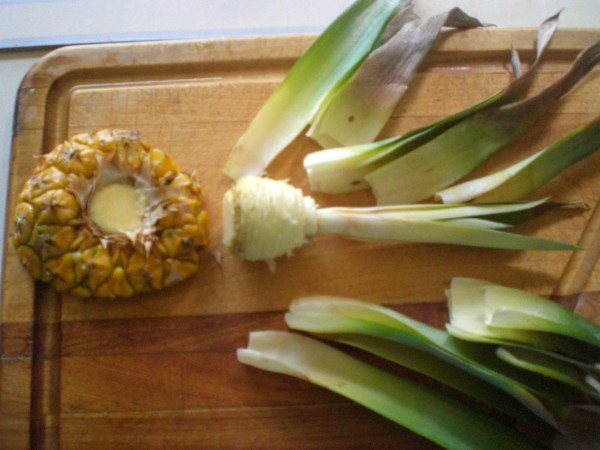

One way to plant a pineapple is by sprouting the top, which resembles a crown with its leaves. You can separate it from the fetus in different ways. The first way, for example, is to gently grab the pineapple leaves with your hand and gradually turn them out as if you were opening a bottle. As a result, the upper part of the plant, which is a foliage with a small and dense stem, will easily separate from the pulp.
The second way to separate the tip for planting is to carefully cut off the green rosette along with two centimeters of the fruit itself. Then it will remain with a knife to remove the remnants of the pulp, which causes rotting.
Preparing to plant the tops of a pineapple in a pot requires careful and thorough inspection of the entire plant.
- If small white dots are visible near the base, then they should be protected. It is from them that the roots of the fruit will grow in the future. So, for example, it is required to tear the lower leaves from the outlet, but it is worth doing this perpendicular to the stem, so as not to damage the small roots.
- If there are cuts on the stem, they must be processed so that this place does not fester and so that the roots germinate faster. Most often, charcoal, potassium permanganate solution or epin are used for processing.
You do not need to immediately plant the top of the pineapple in the soil. First, you should leave it for a few days to dry it. This is necessary to prevent the plant from rotting. It is best to hang the pineapple top prepared for planting for a while so that the cut does not touch anything. And then the tuft should be placed in a glass container with water so that the entire bare stem is covered with liquid. It is necessary to fix the top so that it does not move.
The pineapple top should sit in the water until the roots appear. For this, a container with water, where it will be lowered, is placed in a bright place and the water is changed every two days. Usually the roots germinate after two weeks, and then the plant can be transplanted into a pot. But before planting, it is worth leaving the outlet on a paper towel for a few hours so that it dries slightly.


How to make pineapple bloom
Even with good agricultural practices, the pineapple in the room often refuses to bloom. In this case, its flowering is artificially stimulated, which often leads to success. There are several popular stimulation methods.
Acetylene treatment
This method requires a piece of carbide. You can ask for it from welders or buy it in hardware stores. A piece of carbide, the size of a matchbox, must be thrown into a liter container of water. A violent reaction will begin, resulting in the release of acetylene. When it is over, the acetylene solution is poured into the rosette of leaves (about one tablespoon). The operation is repeated every other day.
You can do it differently. The potted plant is covered with a thick, spacious plastic bag, along with a half-liter jar of water. Throw about 5 grams into the jar.carbide, and cover the pineapple tightly with the jar. Acetylene released during boiling should, if possible, accumulate inside the bag. They do this for three days in a row. But the first option is more efficient!
Fumigation stimulation
Many growers stimulate pineapple flowering by fumigating it. Here, too, you need to cover the pot with the plant with a bag, just put something nearby that emits plentiful smoke: several burning cigarettes, a smoldering torch, steaming coals. The main thing is to observe safety measures so that there is no fire!
Fumigation is repeated 2-3 times, with an interval of about a week.
There is another method that is used not only for pineapples. It consists in putting a ripe apple next to the plant, and also closing them tightly with a bag. If you do this for two weeks in a row, the pineapple can also begin to bloom.
Attention! These stimulation measures only make sense when all the conditions for the flowering of the plant are met. Do not expect a quick result: after stimulation, it may take another 2 months before the peduncle appears from the outlet.
How to choose a pineapple planting pot
If you want to grow pineapple fruit, but you don't know how to plant pineapple in a pot at home, you should carefully read this article: it contains all the necessary information. So, for example, you must definitely pay attention to the choice of a pot for a plant and the selection of soil for it.
The container for growing the fruit should be two centimeters wider than the cut diameter of the plant. Most often, for planting pineapple, pots are taken, which in volume are equal to four liters, and in diameter - fifteen centimeters. Since the plant has a weak root system, which is considered superficial, the container for planting it should not be chosen too deep. A small drainage layer should be placed on the bottom of the pot to allow the water to drain off. Usually pebbles or expanded clay are used for this purpose. This layer helps to protect the root system and prevent decay.
Pineapple is planted in a universal mixture already saturated with all the necessary fertilizers. It is advisable to use a special soil that is designed for tropical plants or palms. You can prepare such a mixture yourself, using peat and river sand in equal proportions. The main condition for the soil is its permeability, since moisture and oxygen must easily get to the root system.
The earth, like the plant itself, must be rendered harmless. To do this, before planting the pineapple in a pot, you need to pour over the ground with boiling water or pour it with a solution of potassium permanganate. But you can't plant a pineapple outlet right away - you need to wait a day. The soil should be slightly moist.
Types of pineapple
Large-crested pineapple (Ananas comosus)
He is also called crested or real. It is the most valuable fruiting variety of the terrestrial Brazilian pineapple. The leading tropical fruit producers are the Hawaiian Islands, followed by the Thai, Philippine, Brazilian and Costa Rican large-scale agricultural enterprises. Spinning fibers are made from tough pineapple leaves in Taiwan and the Philippines.
In open areas, mature plants exceed the meter mark, and tasty fruits well known to us grow on them. A large number of varieties and types of compact sizes of pineapples are widespread in the home.
Bracts pineapple (Ananas bracteatus)
Perfectly adapted to the climatic conditions of Brazil, Paraguay, Bolivia, Ecuador, Argentina. A very nice kind of pineapple with almost meter-long curved bright green leaves with yellowish and white stripes. From the sun's rays, the leaves turn pinkish or reddish.A very famous indoor flower is a variety of the tricolor form - Ananas bracteatus tricolor, which can please with edible fruit crops even in an apartment.
Shiny pineapple (Ananas lucidus)
This variety of pineapple grows, which has bright, decorative, thornless, leaves up to one meter long in Ecuador, Peru, Venezuela, Colombia, Guiana and northern Brazil. The contrast of the red-orange, brown and green colors of the leaves makes the plant especially effective. The blooming purple inflorescence is fragrant with many flowers. Fruits are small in size, 12 cm long and 5 cm wide, consist of strongly fibrous, tasteless pulp.
Indoor Dwarf Pineapple (Ananas nanus)
In this miniature pineapple, the length of the leaves reaches 30 cm. It does not differ in its edible qualities. Like many indoor flowers in the interior , dwarf pineapple can be an excellent representative, which, with its decorativeness and beauty, will bring more comfort, warmth and positive emotions to any room. Flower arrangements with his participation will be irresistible.
Parguazensis pineapple (Ananas parguazensis)
A rare species of pineapple. Found in the territories of South America. The plant has soft leaves that form chic plumes over small fruits that have no commercial interest.
Planting a plant
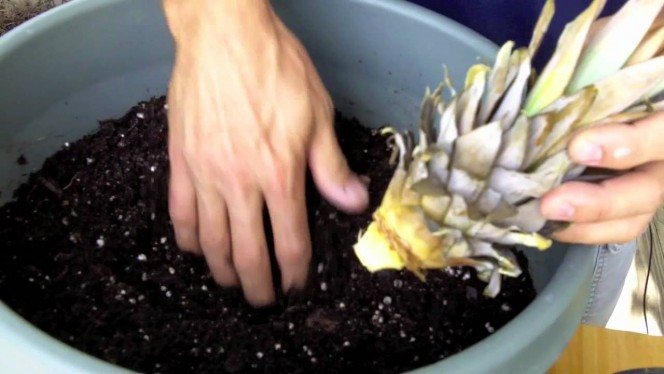

Many gardeners are interested not only in how to choose the right pineapple pot at home, but also in how to plant and grow the plant itself. After the container and soil are ready, you need to make a hole in the ground no more than six centimeters deep. Care must be taken that the bottom layer of leaves is not covered with earth.
The soil should be lightly crushed, trying not to hook on the young and still weak root system. On top of such a hole with a pineapple top, you can sprinkle a little ash or chopped charcoal. Immediately, you need to pour the pineapple in a pot with water at room temperature, and then you should provide the plant with all the necessary conditions for normal growth and strengthening. So, pineapple loves a sunny place, but direct sunlight affects its growth and development negatively, so you should enclose it using polyethylene or plastic bottles.
It is imperative to establish a normal temperature regime. It is known that a pineapple in a pot, the photo of which is in this article, takes root within two to three months. But if the temperature regime is above twenty-five degrees, then this process will take about two months.
The first sign that the plant is living and developing will be the appearance of new leaves. The old ones will dry up over time, and new ones will appear in their place. At the same time, dried leaves must be carefully trimmed.
There are several rules to follow to grow pineapple at home. They refer to the period when the plant is just taking root.
So, when wondering how to grow pineapple in a pot, you should understand that the greenhouse or room where the plant will be located must be constantly ventilated. Therefore, before planting, you should think about where the pineapple will live. After all, the room should not have any temperature changes or hypothermia, as this can cause the death of an exotic fruit.
A decorative pineapple in a pot, which must be carefully cared for, is prone to rotting and the formation of mold on it, so you should carefully study the plant and protect the tuft from condensation - it is he who can lead to a similar state of the fruit. It is usually watered no more than once a week. To prevent the plant from dying and suffocating, it is necessary to move it during the day from the place where direct sunlight can fall on it.
Conditions for pineapple growth
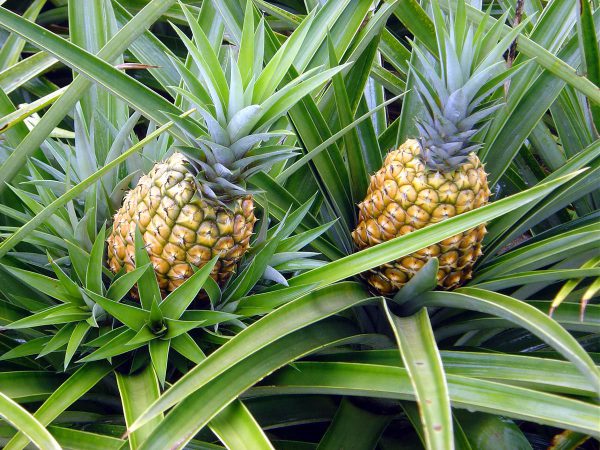

You need to proceed from the fact that this plant is tropical, accustomed to moisture and heat. It is not uncommon to find the statement that pineapples are easy-to-care plants, but this is only partly true when you consider them as decorative flowers. If flowering and fruiting are important, things get more complicated.
Lighting and location
Pineapples are light-requiring, they can easily tolerate even direct sunlight. All year round, daylight hours should be at least 12 hours, which implies mandatory winter supplementary lighting. This is important even for decorative specimens, otherwise the leaves will lose their variegation. In summer, on warm days, it is useful to put pineapple on an open balcony, under ultraviolet light.
Temperature
During the growing season, especially flowering, should be at least + 26 + 28 ° C, better even up to + 32 ° C. At night, the temperature can drop to + 18 + 20 ° C, but no more than 5-6 hours. The same temperatures are acceptable for winter maintenance when the plant is resting. Reacts extremely painfully to the winter cooling of an earthen coma!
Air humidity
It is desirable that it be increased. Regular spraying is helpful, especially on hot days. You also need to spray in the winter if the specimen is not protected from dry room air.
Watering and feeding
Pineapples easily tolerate partial drying of the earthen coma. They must be watered with warm water, with a temperature of about + 30 ° C. This condition applies to both summer and winter rest periods. Water should be taken soft, settled, it will be useful to slightly acidify it (for example, citric or oxalic acid).
As with many bromeliads, it is very important to fill the rosette of leaves with water when watering, especially when the air is hot and dry. At the same time, make sure that the soil itself dries out regularly, even when there is water in the outlet. From time to time, water from the outlet must be poured out so that it does not stagnate for a long time.
Pineapples build up abundant deciduous mass, so they need regular dressing during the growing season. Fertilizers should be added twice a month, focusing on the increased nitrogen content, especially in spring. You can use both special mineral mixtures sold in stores, and organic.
An excellent long-proven fertilizer for pineapples is mullein infusion. You can read how to cook it on many gardening websites. The fact is that in addition to nitrogen, the slurry contains many trace elements useful for the plant.
Pineapple transplant
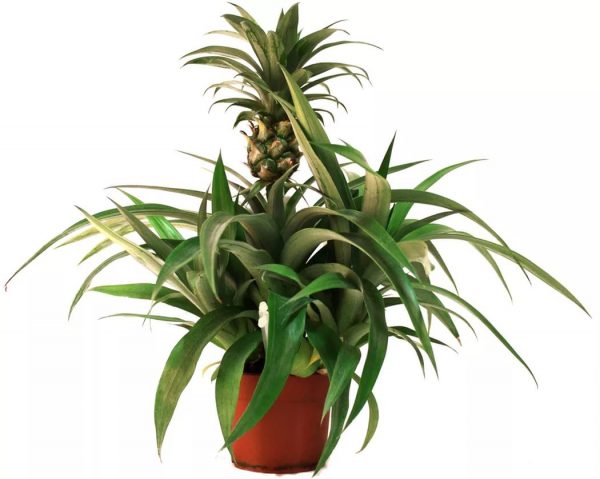

The root system of these large plants is very small. Therefore, adult specimens need to be transferred annually into pots, which only slightly exceed the previous ones in volume. In large containers, pineapple strives to grow children, and does not want to bloom. At the same time, if the pot is very small, it will be difficult for the plant to grow a shoot, which is important. After all, bromeliads, after flowering and fruiting, usually die, leaving behind small side offspring plants.
Attention! Unlike most plants, it is better to replant pineapple not in spring, but in summer.
When transplanting, it is useful to add a small layer of new soil on top of the old one, so that the root collar goes slightly deeper into the substrate each time. In the first year of life, pineapples, if they develop correctly, are transplanted twice.
Care features
There are different opinions about whether it is easy or difficult to grow such an exotic fruit at home. Some believe that the plant is very moody and requires a lot of attention, while others argue that growing pineapple in a pot is not difficult. It will be possible to confirm one of these points of view only after you manage to grow pineapple on your own at home. Therefore, when planning to grow pineapple in a pot, the care of which still requires special attention, flower growers should understand that this plant is very whimsical.And be ready for constant control over the growth of the plant, and for timely transplants, and for the fight against diseases or pests.
All the rules that make it possible to understand how to grow pineapple in a pot relate to correct and competent watering, compliance with the temperature and light conditions necessary for the plant, timely transplantation and feeding of an exotic fruit. From what the weather is outside and what time of the year, it will depend on where you need to put the pot. So, in the summer, a container with pineapple can be taken out to the balcony, but at the same time remember that rains will negatively affect the cultivation - excess moisture can destroy the pineapple.
In winter and autumn, a window sill will become a good place for a plant, only there should be no drafts here. It is also necessary to ensure that there are no hot batteries or other sources of heat near the pineapple. If the leaves of the plant begin to dry or gradually their tips twist, then this is the first sign that the plant is standing in a draft. Hence, it is necessary to move it immediately.
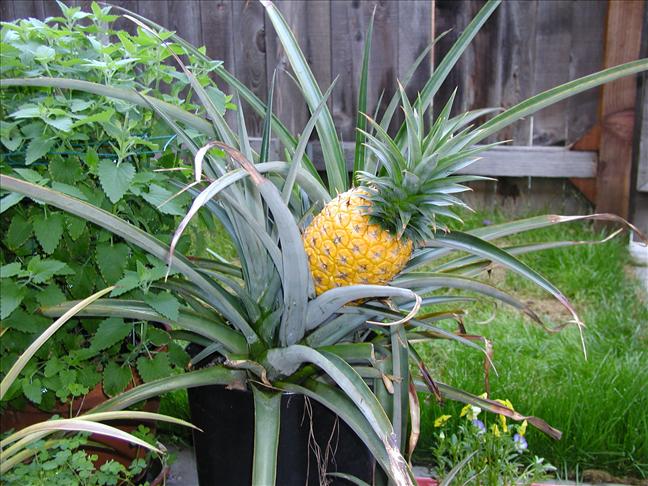

It is always interesting to watch a pineapple grow in a pot. But we must not forget that exotic fruit requires special temperature regimes. So, in summer and spring, the best option is from twenty-two to thirty degrees, and in autumn and winter - from eighteen to twenty-one degrees. Although you can grow pineapple at home in winter and at a maximum temperature of 27 degrees.
It is known that the plant is very afraid of the cold, therefore, when the temperature drops below eighteen degrees, it immediately falls into a state of "hibernation". It also has a hard time tolerating the situation when the room is too hot.
As the pineapple grows in the pot, the photo of which is in the article, you need to monitor the correct lighting of the room. So, six to eight light hours a day will be enough for this plant. In summer, you can put a pot with an exotic plant on the balcony or take it out into the garden, slightly darkening it, but in winter you will also have to use fluorescent lamps.
The fact that the plant lacks lighting can be determined by the leaves, which become pale and unattractive. If this is noticed, then it is worth either rearranging the plant to another, more illuminated place, or immediately start illuminating it with a lamp.
To grow not only a plant, but also to get a fruit, you need to know how to fertilize a pineapple in a pot. It is known that this exotic plant is not too demanding for feeding, but during the growing season, which lasts from April to October, it must be supported with all nutrients. At the same time, organic fertilizers should be applied to the soil no more often than twice a month.
You can also use makeup that is sold in the store, for example, special flower mixes. A solution of ferrous sulfate or humus from manure is also suitable. You can grow fruits without chemical feeding, but then you should use natural. For example, wood ash or lye. By the way, there is no need for top dressing in winter.
Florists who have not grown a pineapple in a pot for the first time know well how to care for it. Therefore, they take care in advance to transplant it into a more spacious container a year after planting. This procedure should be carried out at the beginning of summer. Now in the pot, one third of the drainage layer should take up. And the rest is filled with river sand, peat and fertile soil.
Transplanting a pineapple like this every year in a large container allows you to grow a healthy exotic fruit. In this case, it is necessary to carefully transfer the lump of soil in which the roots of the plant are located. Everything must be done so as not to damage them.
Where does pineapple come from?
Pineapple is a perennial herbaceous epiphytic plant with dense, fleshy leaves gathered in one strong, dense knot called a basal rosette.This rosette forms a massive stem with a peduncle at the top. The peduncle is usually formed high, up to 50 cm, with a spike-shaped inflorescence and a rosette with a bracts.
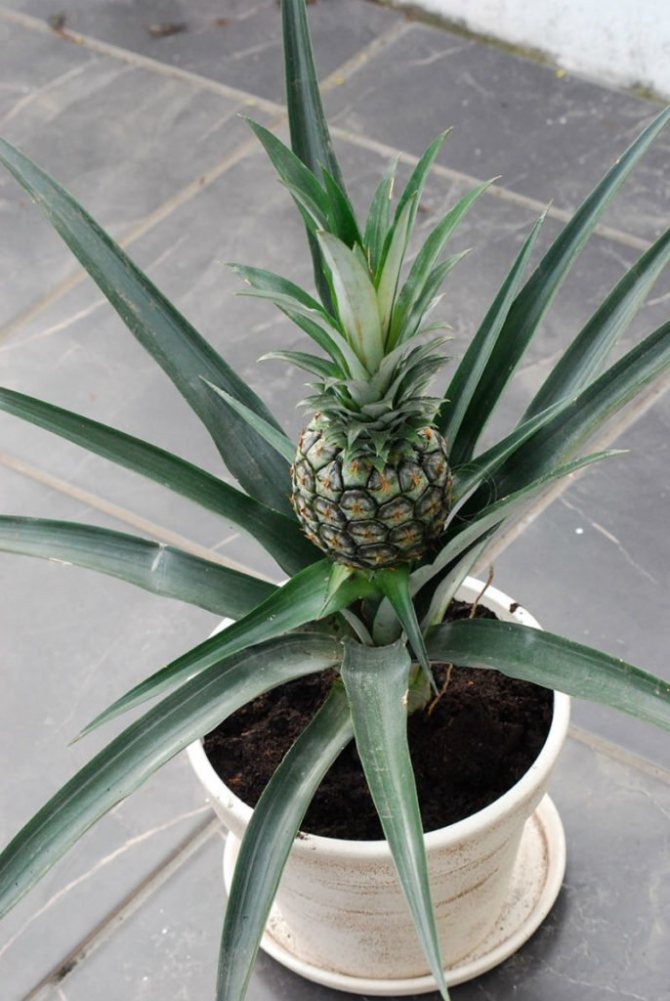

Pineapple has a very exotic look and looks great in a pot.
Pineapple is native to Brazil, although this plant is cultivated in many countries with similar climates.
Pineapple is grown commercially in countries with tropical climates
It appeared in Russia under Catherine II and was grown in public greenhouses.
In the wild, pineapple is accustomed to the bright sun, humid atmosphere and light soil, approximately the same conditions will have to be created on your windowsill for the favorable maintenance of this culture as a houseplant.
Varieties
- Pineapple variety "Caenna" great for home content. The oldest pineapple, popular in the tropics, loved by many for its great taste. The weight of a ripe fruit can be about 600 grams.
- Pineapple variety "Champaka" (champacca) is very often grown as an ornamental plant. Champaca looks really picturesque, like most bromeliads: sharp saw-like leaves, resiliently shooting out of one rosette and ripe golden fruits with conical inflorescences of pink shades.
- Decorative pineapples (Ananas Nanas) are very popular among gardening and landscape design lovers, because they have a colorful appearance and look very colorful among other plants. Decorative varieties of pineapples stand out not only with bright bracts, but also with variegated foliage, red shades.
- Pineapple variety Mauritius (mauritius) has excellent transport capabilities and is often grown commercially. In addition, Mauritius has good taste and is also quite suitable for home cultivation.
- Pineapple variety MD-2 Is a pineapple hybrid developed by the Hawaiian Research Institute under a crop breeding program. It is the international benchmark for quality among market products. The resulting hybrid took root and spread throughout the world. The fruits of MD-2 are very sweet, bright golden in color with a low acidity. The variety is resistant to parasites and internal putrefactive processes.
Photo gallery: pineapple can be different too
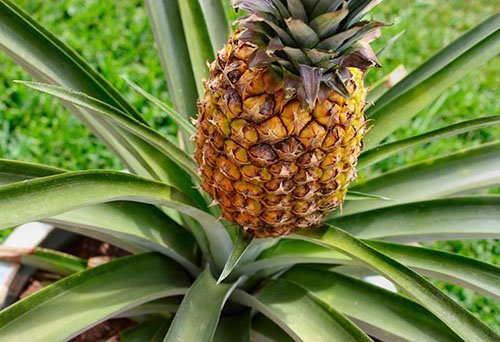

Pineapple variety MD-2


Ornamental pineapple variety, large-crested


Pineapple variety Champaca Pineapple variety Mauritius
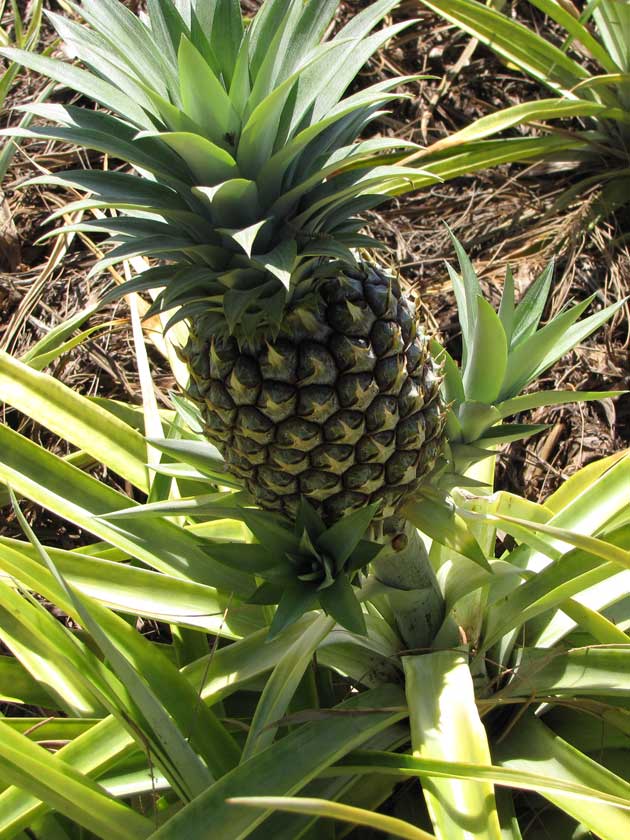

Cayenne pineapple variety
Video: growing pineapples in captivity
Table: seasonal plant content
| Summer | Winter | |
| Temperature | 18 ° C-25 ° C | 18 ° C-20 ° C |
| Watering | abundant | moderate |
| Top dressing | 2 times a month | not |
| Air humidity | spraying | not |
| Lighting | intense | not |
Watering an exotic fruit
So, you became the owner of a plant like a pineapple in a pot. How to care for him is more or less clear. It remains to deal with watering.
It is known that pineapples usually grow in the tropics, so excess moisture can be detrimental to them. Watering such a plant is necessary only when the soil in it becomes almost dry. There should be no stagnation of water in the pot.
Florists pay special attention to watering. How pineapple grows in a pot depends not only on temperature and lighting, but also on how competently all its conditions will be met. So, the pineapple should be watered once a week, using water at room temperature, which should either be filtered or allowed to settle a little.
In summer, the tropical plant needs more moisture, so it can be watered three times a week. In winter, it is enough to limit yourself to once every two weeks. If an unpleasant odor appears from the pot, it means that there is too much moisture. Its redundancy can also be determined by the appearance of mold.If the pineapple leaves begin to dry out, then this is a sign that the plant does not have enough moisture.
If a smell or mold appears in the pot, then the pineapple must be transplanted into another container, otherwise the plant may die. If the trunk begins to rot, then watering should be stopped for a while. If the room where the pineapple is located is well-ventilated, then for a while you can refuse watering and just lightly spray the leaves, which will absorb the required amount of moisture, and the rest will simply evaporate.
Conditions for growing indoor pineapple, how to care
Where does monstera grow in nature - the birthplace of the plant
Growing pineapple at home is easy. In order for it to begin to mature, they follow the rules of care. Wild pineapple naturally grows in hot conditions, which must be approached in an apartment.
Temperature
The plant loves warmth. In the room where he stands, the temperature should be at least +22 ℃. An exotic bush loves good lighting. Often additional illumination is organized for it.
Watering rules and humidity
In summer, pineapple requires abundant watering. The water must be warm, the temperature is not lower than +30 ℃. It is preliminarily defended within one day. In warm weather, an exotic plant needs additional spraying. In autumn and until spring, watering is reduced.
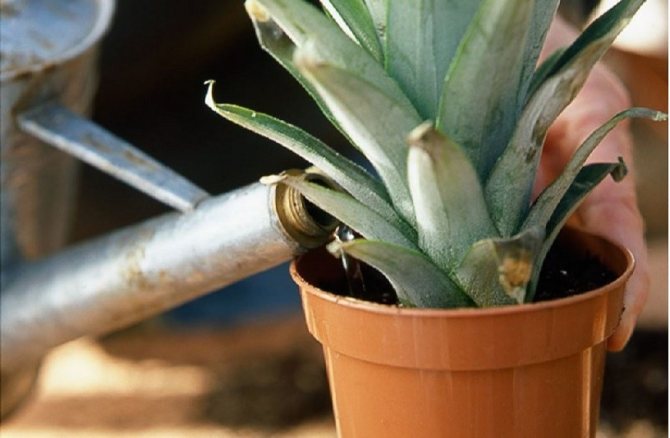

An exotic plant loves moisture
Top dressing and soil quality
The soil for growing pineapple should be acidic and loose. A flower pot is selected low and wide so that the roots are located closer to the surface of the earth.
Note! In the spring and summer, fertilizing is carried out once every two weeks. To do this, use organic fertilizer or mullein infusion.
Flower container size
For pineapple, choose a pot no more than 15 centimeters in diameter. At this size, young roots feel comfortable. To prevent the water from acidifying, they equip drainage holes in the pot.
Reproduction, flowering and fruiting
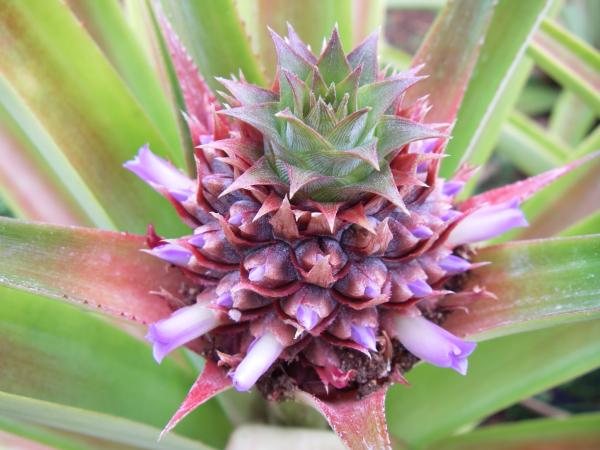

The great interest of flower growers has recently led to the incredible popularity of such an exotic plant as a pineapple in a pot. Can you eat a similar fruit? It all depends on how well it is grown.
This plant blooms from May to July, but there were situations when the pineapple suddenly began to bloom in December. Only those plants that are more than three years old are blooming. They have a compactly located compound fruit, very similar to a lump. The flowering period lasts about two weeks, but the flowers, which attract with their unusual purple color with a blue tint, open only for one day. Moreover, there are usually a lot of them.
As soon as the flowering ends, you need to remove the dried leaves so that the plant goes into the stage of formation and development of the fruit. If flowering did not come, then this means that the care of the plant was incorrect. Do not despair right away, as you can still fix it. For example, stimulate flowering by treating the plant with an aqueous solution of acetylene and ethylene. Someone even uses apples, which release ethylene during storage. It is enough just to put a few fruits in a pineapple pot.
The fruit begins to ripen in about five months. A shortened shoot appears from above, which is called the sultan. The fruit usually ripens within five to six months. This period depends on how it is taken care of, whether all the requirements are met and the peculiarities of the growing season are observed. Immediately after fruiting, the plant dies, but lateral shoots remain, which can be used for reproduction.
Reproduction of pineapples
Actually, we have already described one method. It is called - method using the suprafetal rosette of leaves.


But pineapples are propagated much more often. basal offspring... When the mother plant bears fruit and begins to die, there are already a couple, or even more, children at its base.Do not rush to separate them, let them grow until the adult plant dries up completely. It sometimes takes several months. During this time, children become "youngsters", half the size of a parent.
It is then that they need to be separated from the old plant, and by this time they will most likely have their own roots. Transplant them as described earlier. After transplanting, young pineapples should be kept under the bag until new leaves begin to appear in the center of the outlet.
Seed propagation possible, but rarely used. For it to be successful, you need to be sure that the seeds are ripe. This rarely happens with purchased fruits. If you do decide to give it a try, here are some key tips.
- sickle-shaped, tiny seeds must be removed from the pulp and washed in a pink solution of potassium permanganate. Dry;
- sow in a pre-calcined substrate consisting of a mixture of coniferous soil, peat and sand. Sowing depth - from 1 to 2 cm;
- cover with foil or glass, place in a warm place. Temperature corridor - from + 21 ° С to + 32 ° С. The warmer, the faster the seeds will germinate, but the risk of fungal diseases also increases. Seeds grow very uncommonly, the spread can be several months;
- Do a dive when the plants reach a height of 6-7 cm.

